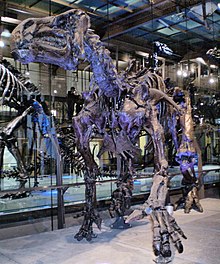
Back Iguanodon AF Iguanodon AN إغواندون Arabic İquanodont AZ Игуанодони Bulgarian Igwanodon BR Iguanodont Catalan Iguanodon CEB Iguanodon Czech Igwanodon CY
| Iguanodon Temporal range: Early Cretaceous (Barremian)
| |
|---|---|

| |
| I. bernissartensis mounted in modern quadrupedal posture, Royal Belgian Institute of Natural Sciences, Brussels | |
| Scientific classification | |
| Domain: | Eukaryota |
| Kingdom: | Animalia |
| Phylum: | Chordata |
| Clade: | Dinosauria |
| Clade: | †Ornithischia |
| Clade: | †Neornithischia |
| Clade: | †Ornithopoda |
| Family: | †Iguanodontidae |
| Genus: | †Iguanodon Mantell, 1825[1] |
| Type species | |
| †Iguanodon bernissartensis Boulenger in Beneden, 1881
| |
| Other species | |
| |
| Synonyms | |
| |
Iguanodon (/ɪˈɡwɑːnədɒn/ i-GWAH-nə-don; meaning 'iguana-tooth'), named in 1825, is a genus of iguanodontian dinosaur. While many species found worldwide have been classified in the genus Iguanodon, dating from the Late Jurassic to Early Cretaceous, taxonomic revision in the early 21st century has defined Iguanodon to be based on one well-substantiated species: I. bernissartensis, which lived during the Barremian to early Aptian ages of the Early Cretaceous in Belgium, Germany, England, and Spain, between about 126 and 122 million years ago. Iguanodon was a large, bulky herbivore, measuring up to 9–11 metres (30–36 ft) in length and 4.5 metric tons (5.0 short tons) in body mass. Distinctive features include large thumb spikes, which were possibly used for defense against predators, combined with long prehensile fifth fingers able to forage for food.
The genus was named in 1825 by English geologist Gideon Mantell, based on fossil specimens found in England and was given the species name I. anglicus. Iguanodon was the second type of dinosaur formally named based on fossil specimens, after Megalosaurus. Together with Megalosaurus and Hylaeosaurus, it was one of the three genera originally used to define Dinosauria. The genus Iguanodon belongs to the larger group Iguanodontia, along with the duck-billed hadrosaurs. The taxonomy of this genus continues to be a topic of study as new species are named or long-standing ones reassigned to other genera.
In 1878 new, far more complete remains of Iguanodon were discovered in Belgium and studied by Louis Dollo. These were given the new species I. bernissartensis. In the early 21st century it became understood that the remains referred to as Iguanodon in England belonged to four different species (including I. bernissartensis) that were not closely related to each other, which were subsequently split off into Mantellisaurus, Barilium and Hypselospinus. It was also found that the originally described type species of Iguanodon, I. anglicus is now a nomen dubium, and not valid. Thus the name "Iguanodon" became fixed around the well known species based primarily on the Belgian specimens. In 2015, a second valid species, I. galvensis, was named, based on fossils found in the Iberian Peninsula.
Scientific understanding of Iguanodon has evolved over time as new information has been obtained from fossils. The numerous specimens of this genus, including nearly complete skeletons from two well-known bone beds, have allowed researchers to make informed hypotheses regarding many aspects of the living animal, including feeding, movement, and social behaviour. As one of the first scientifically well-known dinosaurs, Iguanodon has occupied a small but notable place in the public's perception of dinosaurs, its artistic representation changing significantly in response to new interpretations of its remains.